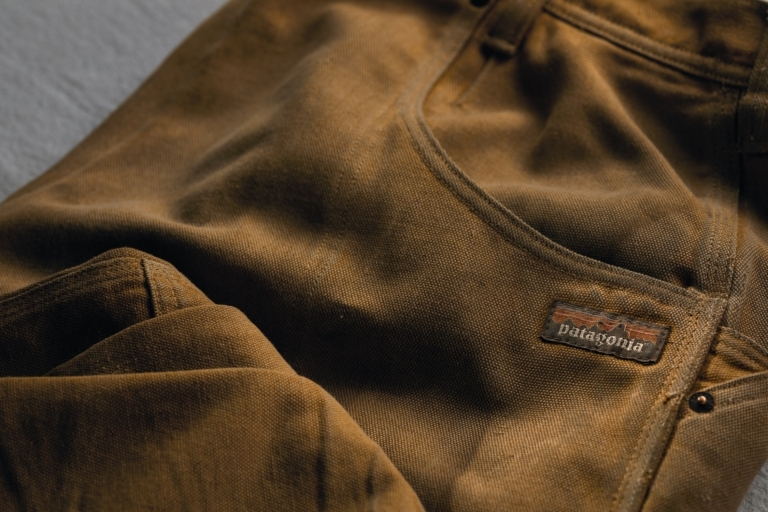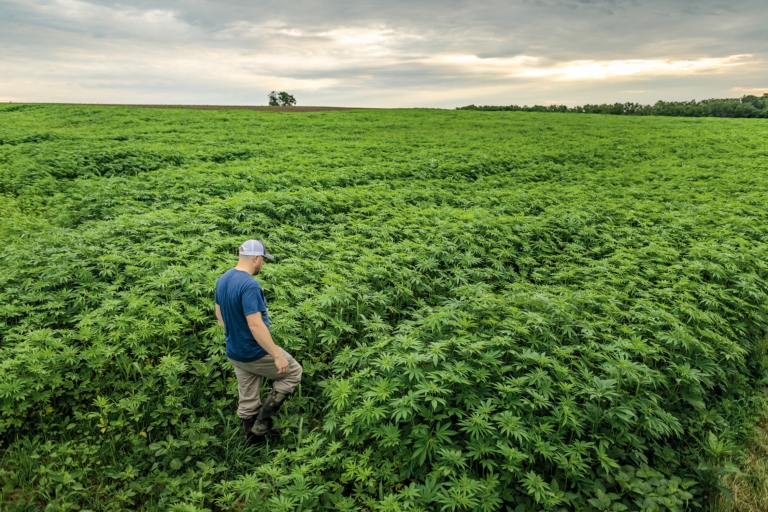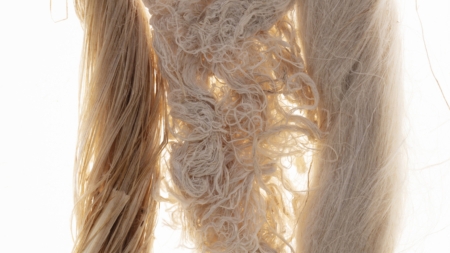All the Hemp That Fits
Humans and hemp have been intertwined since the Neolithic period. Over the centuries, we’ve used its fibers to make everything from textiles to the rigging rope that helped sailors circumnavigate the globe. Hemp has long been trusted with our heavy lifting, but why? This magical plant has a large number of hydrogen bonds and a linear molecular structure that give it the simple, no-nonsense strength of a chain—a long chain, in fact. In good growing conditions, the hemp stem can reach over 13 feet high, which means 13 feet of cellulose fibers that can be woven to make durable cloth and cordage.
Hemp’s chainlike fibers are held together by lignin, a natural glue that allows them to grow in dense bundles and attaches them to a biomass-rich woody core called the shive. In order to separate the fibers from the shives, farmers leave harvested hemp stems in piles so microorganisms can get to work breaking down the lignin, a process known as retting. Unsurprisingly, there are a number of nasty chemicals that can expedite the retting process, but we prefer the age-old method of letting nature do its thing. Shives can then be pulverized into hemp “hurd” and used as a natural input for bioplastic products and molded components like automotive interior panels, insulation, laminated flooring and hempcrete bricks.

For our Workwear line, we created Iron Forge Hemp® canvas by blending industrial hemp with organic cotton and recycled polyester. It’s 25% more abrasion resistant than conventional cotton duck canvas, breathable and broken-in right off the shelf.
Hemp fibers, when blended, can complement natural and synthetic fibers in strong and elegant ways, from rope to rugs to rugby shirts. The durable yet supple canvas used for our Workwear line was created by combining hemp with organic cotton and recycled polyester. Hemp can also be used for airy, open-weave constructions, and it can be mixed with materials like organic cotton and TENCEL™ lyocell. We lean on hemp’s breathability, odor-mitigating properties, abrasion resistance and natural drape to craft comfortable clothing that you can wear all day long.
And that’s only what this magical weed does above the surface. As a crop, hemp’s long center taproot deeply penetrates even the hardest and most nutrient-depleted ground. It can draw nutrients and microbes from lower layers of soil to help regenerate topsoil that’s been damaged by years of tilling and industrial agriculture. Recent studies show that hemp acts as a phytoremediator—a plant that can remove, stabilize and/or destroy contaminants in our soil, air and water.
Now that industrial hemp is once again legal to grow in most states, we’re excited about helping to resurrect lost knowledge around its cultivation and processing, and we remain on the lookout for new ways this plant can help us clean up our act. It’s time to put hemp back to work.

Lane Butler takes a moment to check our first-ever US hemp crop. He planted the seeds in the summer of 2019 and used no irrigation, pesticides or synthetic fertilizer. A few weeks later, the crop was taller than him. Butler Farm, Paris, Kentucky. Photo: Forest Woodward
Update from the Highest State
Colorado translates to “colored red” in English, but lately, Colorado has been trending green. Early this year, Patagonia partnered with the Colorado Department of Agriculture to plant 319 acres of industrial hemp (60 of those acres organic) on Dion Oakes’s fifth-generation family farm in Del Norte, Colorado. But 80 years of hemp criminalization in the United States has left most American farmers in the dark about how to grow this crop.
Enter Hongliang Ding, president of Hemp Fortex, our hemp supplier in the mountains of northern China. Ding’s original plan was to travel to Oakes’s farm to share his knowledge around planting, growing, harvesting and processing industrial hemp, but the pandemic forced him to communicate via a series of conference calls instead. Agronomists from Colorado State University also joined the party to run soil tests and to learn crop spacing techniques from Ding.
At the time of this writing, the crop is being harvested, retted and dried on Oakes’s farm. Which leads us to our next frontier: how to turn all this hemp into usable fiber, yet another skill that’s been dormant in the US for almost a century.
Colorado-based Formation Ag has stepped up to provide a domestic solution for processing our hemp by building equipment specifically engineered for this purpose. There are still many unknowns, a lot to learn and no guarantees, but we’re pretty darn excited about this joint effort and by the possibility of pulling on a pair of Workwear pants that were grown and processed in ol’ Colorady. We’re also hopeful that the resurgence of this cash crop can help farmers, their families, their communities and the soil they depend on to make a living. We’re getting there, and as our hemp farmer friend Doug Fine likes to say, “This time, the farmers are in charge.”
Visit patagonia.com to see the entire Hemp collection.
This essay appeared in the Fall 2020 Patagonia Journal.



